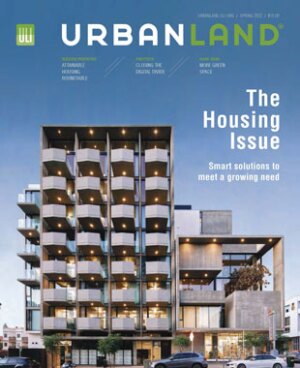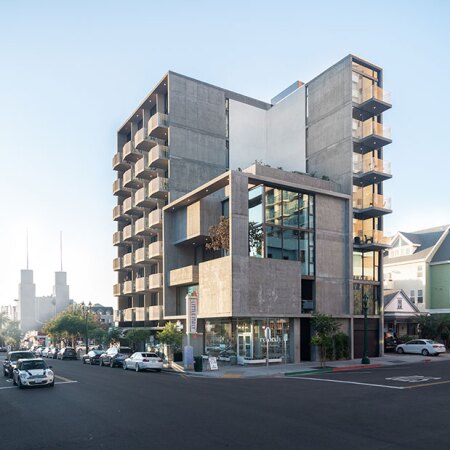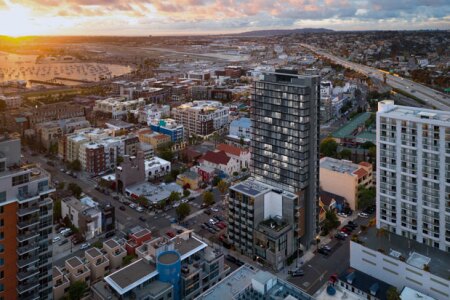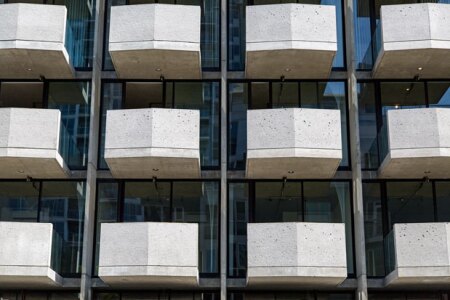Urban Land’s Spring 2022 cover depicts a groundbreaking micro-housing project in the heart of downtown at 320 West Cedar Street in San Diego’s Little Italy. Designed, developed, owned, and managed by local architect Jonathan Segal, the 42-unit structure features 5 low-income apartments, two commercial retail spaces on the ground floor, and a distinctly separate single-family townhouse designed by Matthew, his son, that looks like a cube on the corner. And all on a 5,000-square-foot postage stamp size lot.
Like all of Segal’s projects—he now owns and rents 160 units in 5 buildings in and around San Diego—The Continental began as an experiment. This time, the architect cum developer (cum general contractor cum owner cum property manager) wanted to provide housing for people who worked downtown who didn’t have cars. The result: micro workforce houses at a price point of 65 percent of the average market rent.
The architect’s penchant for experimentation has earned him dozens of top local, state, and national accolades from groups like the American Institute of Architects for residential and urban design. In mid-2020, he was awarded Master Architect for the City of San Diego, the youngest architect at then 59 to receive the honor in a field with 5 living recipients whose average age is 91. He was also awarded California State AIA’s 2021 Maybeck Award for career design work.
Urban Land spoke with Segal about The Continental and his innovative approach to projects that push the envelope of possibilities.
What makes your firm stand out?
Segal: We don’t have any clients. We do our own work. We develop our own work. Each project that we do is sort of an experiment of what we think is pertinent to the time or germane to what is at issue at the time.
Every time we do something, it’s rooted in architecture—it’s not from development. It’s not numbers. It’s not beans. It’s not density. It is: What is right and what are we trying to investigate as an urban architectural experiment?
The Continental was created because the housing downtown was expensive and we needed to create some kind of workforce housing so people who didn’t have cars and could not pay the extra freight for a parking space could have a unit and we wouldn’t have to build an underground parking garage, which would save us money. And that was the genesis of what we wanted to do. We wanted to provide urban workforce housing.
How was this project informed by the California housing crisis and what are the chief obstacles to getting this type of affordable project done?
Segal: This was our answer to the current housing affordability crisis. It’s the law of economics; it’s supply and demand. If there’s big demand, and little supply, things get expensive. There’s a whole bunch of supply and no demand, things get real cheap.
I don’t think that the cities are allowing us to build quickly enough and easily enough and efficiently enough. They’re still getting in our way. They’re just not letting the gates open. It’s amazing to try and get something processed still. The fees are outrageous. I wish that we could work closely with cities to vet issues that would make it more efficient to process a building permit—clearly, that would be the key to the supply issue.
What inspired the design of The Continental?
Segal: We wanted to develop a project with no parking. Its façade of balconies is patterned after a Lincoln Continental car grill. So if you look at the pattern of the late ‘50s Lincoln Continentals, the grills in front of the radiators have a pattern and that was the genesis of a pattern created with the decks. Everything is car-related for me. I collect ‘50s Italian cars and ‘50s and ‘60s American cars. There is an incredible design vocabulary in these cars that I build from.
When did it come online and who is your target renter?
Segal: It was two years ago in December 2019. What we’re trying to do is we’re trying to make it for the people who actually work in Little Italy to live in Little Italy. So if you’re a bartender and you walk three blocks to work, you don’t need to pay $400 for a car payment, another $200 for license and insurance, which is $700 a month. You can apply that to your lifestyle and/or your unit. And if I can make your unit $700 or $800 less expensive a month because it doesn’t have a parking space attached to it, there’s more savings. So it’s just all-around lifestyle savings for people that can’t afford expensive downtown. The rents for 37 of the units, which are 350 square feet or less, are $1,595 to $1,995 with affordable ones at about $900 a month.
Initially, when it came online, this was an experiment. This was sketchy, risky. They didn’t immediately rent up. We had to get our market of the people without the cars in and that was a tight, small market at the time; it’s grown significantly now.
Social interaction is important in urban architecture, so we created an outdoor space at the top of the building, facing the ocean, facing the San Diego Bay. It then has its washer and dryer room connected to it so you can go up and be social, do your laundry, and then socialize with people in the building and have a fabulous view you couldn’t afford because you can only afford the unit on the second floor. So very democratic the way it enables all people to enjoy the best parts.
It is a very good product type to develop provided you don’t have to provide parking for it. And we’re seeing that all over San Diego now; we’re seeing a lot of developments. We do by example, and they copy. They’re everywhere now.
What makes your micro-housing design unique?
Segal: Besides bringing a substantial reduction in parking, we brought large individual private outdoor living spaces to indoor living. That is extremely important in a small rental and also to capture the incredible San Diego weather. And we brought an efficient layout of living space. It’s 350 square feet or less and we have a big, huge sheet of glass at the end of it so the space feels like it’s larger whereas typical developers put a four-by-four or five-by-five window at the end, this is a full-blown, huge commercial-grade window system and a nice patio that’s eight by eight.
It’s only been two years but what kind of turnover are you seeing?
Segal: Our tenants are staying. We were wondering about the units being so small if the turnover would be more than the larger complexes with the larger units and the answer is no, it’s basically the same. It’s crazy. It’s also important to remember Matthew developed a single-family residence and placed it over his Remedy Pharmacy. This living over the store row house is another typological pattern that needs to be understood in urban San Diego regardless of the unit type. We try to be a little less expensive, so we have less turnover because turnover is costly.
What are the sustainable elements of The Continental?
Segal: No parking, no cars, more transit use, more walking, more healthy lifestyle. We have nominal parking, 9 parking spaces for 40 units. And if you’re walking and your neighbor’s not because your neighbor has a car and you’re walking a mile or two a day, you’re going to be healthier. Your being healthier is going to help with your longevity. It’s going to help the medical system—it’s on and on and on. Sustainability isn’t just using bamboo floors. You know, it’s an idea, not necessarily a product. People get that confused. High density is sustainable. Urban suburban sprawl is not. I don’t care if you’re making it out of recycled building paper—your whole house—it doesn’t matter. You’re burning fossil fuels to get from here to there.
I have the most efficient mechanical electrical units that you can buy. The building is made out of concrete so the maintenance on the building is almost nothing. I’m not painting it. I’m not staining it. I’m not doing any redos. The storefront is an expensive product that lasts longer than cheap builder/developer windows. Operable windows for cross ventilation so you don’t have to run an air conditioning system if you don’t want to. We have complete solar, as much as we can fit on the roof to offset the building expenses. We don’t have batteries.
How much does the solar offset the building expenses?
Segal: It covers about 80 replace of the building itself, not the units. We just don’t have enough physical real estate area up there. We would have put more but there’s the physical square footage of the buildable solar area limited us, which is pretty typical for urban housing. You’re limited by your roof.
Do the smaller units make the math work but also mean more management?
Segal: Yes, smaller units allow us to charge less rent. And yes, you’re going to have a couple more units of turnover just by the mere fact that a percentage on a higher number is going to equate to more move-outs. So it is more labor-intensive or management intensive to manage smaller units. Without a doubt, there’s no question.
Does it have any green certifications such as LEED?
Segal: We don’t believe in that. We’d rather spend the money on the building making it green rather than spending ten grand on some certification expert to certify that we’ve done what we’re supposed to do.
This is also a mixed-use project…
Segal: We have two retail spaces. Matthew actually lives above the store like my wife and I have done since 1989. He has a holistic pharmacy called Remedy with his wife and they’re raising their first child there, Oliver.
You mentioned another rowhouse development where you created fee simple ownership over 30 years ago…
Segal: I was trying to get a fee homeownership to downtown and I cut a 15,000 square foot property into 15-foot-wide lots. And then I created something I call ‘convertible housing.’ I’m going to give you the opportunity to have sort of an extra flex space that you can either have your home office in or you could rent out as a separate unit. And if you bought one of the homes that also came with a granny flat, there would be an additional commercial space under your row house. Physically you had your business below and your home above, no commute required. And you can also rent out those spaces for income. So if you get the down payment from your parents, effectively you can live out of it for free. And that was my first foray into developing fee simple living at home and working at home. That was ‘98 and we called the project Kettner Row.
How do you replicate the best of The Continental in other projects?
Segal: We are now starting to incorporate micro-units as part of our product types. So the building next door, the high-rise—25 replace of the units are 350 square feet.
What’s your next project?
Segal: It’s a high-rise that we’re currently getting ready to build next door to The Continental. And because we own contiguous properties next to each other, we are able to for a maximum building height basement of the Continental property and this basement allows us to have a glass wall on the property lines that we wouldn’t be able to otherwise have.
We bought a 50-by-100-foot lot and we developed a 73-unit, 23-story tower there on it. We have an automated parking system that goes with that, which is kind of a first of its kind in San Diego. Typically, a downtown building has got maybe six levels below grade of parking. So you drive into a hole and you spiral down six floors to a space that has bad air and maybe encounter unsavory people without any security.
Our system basically takes half the area of a conventional garage. Your car rolls into this little vestibule parking, and you get out and the machine comes and takes it away. And then it puts it on an elevator, and it stacks it on the eight-story parking area against the building where we don’t have windows. And we’re doing it on a non-buildable lot—50 by 100—in downtown San Diego, so there’s an experiment. There’s a demonstration. No one’s done it. So there’s an opportunity.
Where does the project stand now?
Segal: We hope to break ground in September. We’re in the final process of getting our entitlements and our building permits. The cost of the building is around $31 million construction costs for 73 apartments. We’re giving away eight units to the city of San Diego free of charge for affordable housing. So the city doesn’t have to put a dime out and they’re getting these subsidized units that are about 35 percent on the dollar for rent so if it’s a $3,000 unit, it’s $1,000. If it’s a $4,000 unit, it’s $1,300. It creates a pretty good deal for everybody.
SIBLEY FLEMING is the editor in chief of Urban Land.







![Western Plaza Improvements [1].jpg](https://cdn-ul.uli.org/dims4/default/15205ec/2147483647/strip/true/crop/1919x1078+0+0/resize/500x281!/quality/90/?url=https%3A%2F%2Fk2-prod-uli.s3.us-east-1.amazonaws.com%2Fbrightspot%2Fb4%2Ffa%2F5da7da1e442091ea01b5d8724354%2Fwestern-plaza-improvements-1.jpg)


